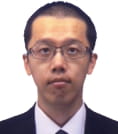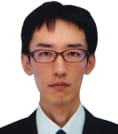- JST Home
- /
- Strategic Basic Research Programs
- /
 PRESTO
PRESTO- /
- project/
- Thermal Science and Control of Spectral Energy Transport/
- [Thermal Control] Year Started : 2019
[Thermal Control] Year Started : 2019
Roman Anufriev
Ray-Phononics for Advanced Heat Flux Management
Researcher
Roman Anufriev

Project Associate Professor
Institute of Industrial Science
The University of Tokyo
Outline
I develop highly advanced thermal conduction technique using the particle properties of phonons and their ballistic transport, which is named “Ray-phononics”. First, I’ll study the limits of ballistic heat conduction in semiconductor nanostructures, such as silicon membranes. Then, I’ll develop and simulate various ray-phononic devices for heat guiding, cloaking, focusing etc. Finally, I plan to demonstrate these devices experimentally using newly developed thermal measurement technique. This research will open new possiblity in thermal management in semiconductors, which can find applications in modern microelectronics
Satoshi Ishii
Heating and cooling by nanostructures optimized for light and heat transfer
Researcher
Satoshi Ishii

Principal Researcher
International Center for Materials Nanoarchitectonics
National Insitute for Materials Science
Outline
An object can be heated when the object absorbs light and an object can be cooled when the object emitts light. In the current project, we aim to enhance heating and cooling performances with light by optimzing the nanostructures for both light propagation and heat transfer. One of the key strategies is to perform multi-physics analysis which simutaniously solves light propagatoin and heat transfer. The typical research procedure starts by designing nanostructures by the numerical method, followed by sample fabrication and optical and thermal charactalization. Our research could lead to efficient heating and cooling of objects by light which is useful for heat managment where light is involved.
Kenji Okada
Thermal transport by crystalline porous nanomaterials: fundamental insight and management
Researcher
Kenji Okada

Associate Professor
Graduate School of Engineering
Osaka Metropolitan University
Outline
This project aims to understand a relationship between ‘molecular/nanometer-scale structures’ and ‘thermal transport’ by using oriented films of metal-organic framework (MOF), which is a crystalline porous nanomaterial with ordered pores and frameworks in a molecular/nanometer-scale. In addition to the fundamental research, a development of controllable thermal transport technologies such as ‘anisotropic thermal transport’, ‘frequency-dependent thermal transport’ and ‘switching a direction of thermal transport’ is attempted on the basis of ‘understanding thermal transport in a molecular/nanometer-scale’.
Makoto Kashiwagi
Control of thermal transport by crystalline structural control of disordered materials with nonequilibrium state
Researcher
Makoto Kashiwagi

Assistant Professor
School of Science & Engineering
Aoyama Gakuin University
Outline
In this work, I will reveal physics of phonon transport in disordered-crystalline materials such as amorphous and mixed crystal from the viewpoint of atomic ordering, and realize novel control of phonon transport by using disordered-crystalline materials with atomic ordering control. The work leads to realizing novel thermally functional materials such as super thermal conductive amorphous materials and super thermal insulating solid materials.
Yusuke Kajihara
Nanoscale thermal spectroscopy via thermally excited evanescent waves
Researcher
Yusuke Kajihara

Associate Professor
Institute of Industrial Science
The University of Tokyo
Outline
The objective of the project is to develop a spectroscopy technique to investigate nanoscale thermal transfer/distribution on material surface. I intend to realize near-field spectroscopy of terahertz evanescent waves derived from thermal charge/current fluctuation to provide a novel measurement method for heat transfer. With the developed method, I am going to analyze energy dissipation on small circuits and other devices, and to develop nonlinear heat transfer devices by utilizing thermally excited evanescent waves.
Atsushi Sakurai
On the Possibility of Far-field Super Planckian Radiative Heat Transfer
Researcher
Atsushi Sakurai

Associate Professor
Faculty of Engineering
Niigata University
Outline
In the present study, a scientific principle of far-field Super-Planckian radiative heat transfer is pursued. Focusing on far-field coherent thermal radiation by metamaterials, this photon transport mechanism will be elucidated. Radiative transport exceeding the blackbody limit will be realized, and the radiation mechanism will be freely controlled. This study can contribute to realize a future smart energy society by advancing thermo-photovoltaic power generation based on this principle.
Liwen Sang
Optimizing the interface phonons transport for thermal dissipation through polarization field engineering
Researcher
Liwen Sang

Independent Scientist
International Center for Materials Nanoarchitectonics
National Insitute for Materials Science
Outline
The bottleneck of the thermal dissipation for GaN power devices is the large thermal boundary resistance between GaN and the heat spreader diamond due to their acoustic mismatch. In this project, we propose to enhance the phonon transmission probability for the maximum heat transfer through inducing a tunable piezoelectric polarization field. The GaN/AlN nano-laminated structure with the large piezoelectric field is proposed as the transition layer between GaN and diamond. The phonon transport behavior at each interface will be investigated by using the NEMS/MEMS technology. The in-situ temperature detection is expected by analyzing the variation of MEMS resonance frequency. The power limit of the GaN technology will be achieved with this highly effective thermal management method.
Kunio Fujiwara
Numerical study on non-equilibrium thermal transport at single-atom scale based on molecular dynamics method
Researcher
Kunio Fujiwara

Assistant Professor
Graduate School of Engineering
Osaka University
Outline
Thermal transport phenomena at interfaces are important phenomena in thermal science and engineering, which are expected to be controlled to maintain and develop modern societies. This study aims to reveal a new picture and principle of interfacial thermal transports by detecting the heat flux at the single-atom scale based on molecular dynamics method. Based on the spectral properties of the heat flux detected at the single-atom scale, this study also aims to create a methodology to modulate the thermal transport properties at interfaces.
Shohei Horike
Thermoelectric device with heat-dissipation ability
Researcher
Shohei Horike

Assistant Professor
Graduate School of Engineering
Kobe University
Outline
Reusing abundant waste heat as electricity is an important issue for realizing sustainable society. On the other hand, removing heats from driving electronic devices is essential for future high-density integrations of semiconductors. However, these thermal managements have been considered incompatible each other as thermoelectric conversion based on Seebeck effect usually requires materials with low thermal conductivities. In this project, a new thermoelectric principle that enables both power generation and heat dissipation will be demonstrated via visualizing the heat transporting abilities of a new class of liquids with Coulomb-effect-induced giant latent heats as well as converting the charge flows of the liquids into voltages.













